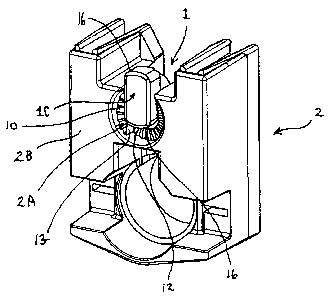Une partie des informations de ce site Web a été fournie par des sources externes. Le gouvernement du Canada n'assume aucune responsabilité concernant la précision, l'actualité ou la fiabilité des informations fournies par les sources externes. Les utilisateurs qui désirent employer cette information devraient consulter directement la source des informations. Le contenu fourni par les sources externes n'est pas assujetti aux exigences sur les langues officielles, la protection des renseignements personnels et l'accessibilité.
L'apparition de différences dans le texte et l'image des Revendications et de l'Abrégé dépend du moment auquel le document est publié. Les textes des Revendications et de l'Abrégé sont affichés :
| (12) Brevet: | (11) CA 2618483 |
|---|---|
| (54) Titre français: | REGLEUR DE FRICTION POUR SUPPORTS D'EQUILIBRAGE DE CHASSIS DE FENETRE |
| (54) Titre anglais: | FRICTION ADJUSTER FOR WINDOW BALANCE CARRIERS |
| Statut: | Accordé et délivré |
| (51) Classification internationale des brevets (CIB): |
|
|---|---|
| (72) Inventeurs : |
|
| (73) Titulaires : |
|
| (71) Demandeurs : |
|
| (74) Agent: | BORDEN LADNER GERVAIS LLP |
| (74) Co-agent: | |
| (45) Délivré: | 2011-03-29 |
| (22) Date de dépôt: | 2008-01-17 |
| (41) Mise à la disponibilité du public: | 2009-07-17 |
| Requête d'examen: | 2008-01-17 |
| Licence disponible: | S.O. |
| Cédé au domaine public: | S.O. |
| (25) Langue des documents déposés: | Anglais |
| Traité de coopération en matière de brevets (PCT): | Non |
|---|
| (30) Données de priorité de la demande: | S.O. |
|---|
L'invention a trait à un dispositif actionnable permettant de régler le degré de friction d'un mécanisme de châssis de fenêtre. Le régleur de friction est muni d'une interface d'entraînement qui agit sur l'interface de réglage de friction asservie à l'interface du porteur, de telle sorte que dès que ce mécanisme est actionné en faisant tourner celui-ci dans une fente oblongue du porteur, son interface agit sur l'interface du régleur de friction et force un élément de réglage situé à l'arrière à appliquer graduellement une pression croissante sur la partie adjacente d'une cannelure de fenêtre.
A carrier for a window sash having an actuatable friction adjuster. The friction adjuster has a carrier interface that interacts with a mating friction adjuster interface of the carrier such that the actuation of the friction adjuster by rotating it within an oblong slot in the carrier causes the carrier interface to interact with the friction adjuster interface and forces a rear portion of the friction adjuster into progressively increasing frictional contact with an adjacent portion of a window frame sash channel.
Note : Les revendications sont présentées dans la langue officielle dans laquelle elles ont été soumises.
Note : Les descriptions sont présentées dans la langue officielle dans laquelle elles ont été soumises.

2024-08-01 : Dans le cadre de la transition vers les Brevets de nouvelle génération (BNG), la base de données sur les brevets canadiens (BDBC) contient désormais un Historique d'événement plus détaillé, qui reproduit le Journal des événements de notre nouvelle solution interne.
Veuillez noter que les événements débutant par « Inactive : » se réfèrent à des événements qui ne sont plus utilisés dans notre nouvelle solution interne.
Pour une meilleure compréhension de l'état de la demande ou brevet qui figure sur cette page, la rubrique Mise en garde , et les descriptions de Brevet , Historique d'événement , Taxes périodiques et Historique des paiements devraient être consultées.
| Description | Date |
|---|---|
| Lettre envoyée | 2024-03-14 |
| Inactive : Certificat d'inscription (Transfert) | 2024-03-14 |
| Inactive : Transferts multiples | 2024-03-07 |
| Représentant commun nommé | 2019-10-30 |
| Représentant commun nommé | 2019-10-30 |
| Accordé par délivrance | 2011-03-29 |
| Inactive : Page couverture publiée | 2011-03-28 |
| Préoctroi | 2010-11-29 |
| Inactive : Taxe finale reçue | 2010-11-29 |
| Un avis d'acceptation est envoyé | 2010-06-02 |
| Lettre envoyée | 2010-06-02 |
| Un avis d'acceptation est envoyé | 2010-06-02 |
| Inactive : Approuvée aux fins d'acceptation (AFA) | 2010-05-27 |
| Modification reçue - modification volontaire | 2010-02-17 |
| Inactive : Dem. de l'examinateur par.30(2) Règles | 2009-10-23 |
| Demande publiée (accessible au public) | 2009-07-17 |
| Inactive : Page couverture publiée | 2009-07-16 |
| Inactive : CIB attribuée | 2009-02-03 |
| Inactive : CIB en 1re position | 2009-02-03 |
| Inactive : CIB attribuée | 2009-02-03 |
| Inactive : CIB attribuée | 2009-02-03 |
| Inactive : Certificat de dépôt - RE (Anglais) | 2008-02-27 |
| Lettre envoyée | 2008-02-27 |
| Demande reçue - nationale ordinaire | 2008-02-27 |
| Exigences pour une requête d'examen - jugée conforme | 2008-01-17 |
| Toutes les exigences pour l'examen - jugée conforme | 2008-01-17 |
Il n'y a pas d'historique d'abandonnement
Le dernier paiement a été reçu le 2011-01-11
Avis : Si le paiement en totalité n'a pas été reçu au plus tard à la date indiquée, une taxe supplémentaire peut être imposée, soit une des taxes suivantes :
Les taxes sur les brevets sont ajustées au 1er janvier de chaque année. Les montants ci-dessus sont les montants actuels s'ils sont reçus au plus tard le 31 décembre de l'année en cours.
Veuillez vous référer à la page web des
taxes sur les brevets
de l'OPIC pour voir tous les montants actuels des taxes.
Les titulaires actuels et antérieures au dossier sont affichés en ordre alphabétique.
| Titulaires actuels au dossier |
|---|
| ASSA ABLOY FENESTRATION, LLC |
| Titulaires antérieures au dossier |
|---|
| JEFFREY CHARLES ROBERTSON |